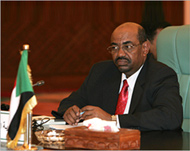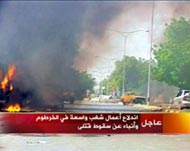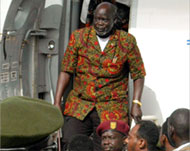Khartoum riots kill dozens
Supporters of a former Sudanese rebel leader tore through the capital in riots on Monday, killing 36 people, smashing cars and shops and blaming the government for his death in a helicopter crash.

Despite doubts among the rioters, the southern rebel movement dismissed talk on Monday of a plot against Vice President John Garang, and sought to keep alive the fragile north-south peace deal he had championed for Sudan.
Garang, 60, who had been Sudan’s first vice president for three weeks, died on Saturday along with 13 others when their helicopter crashed into a mountain in southern Sudan in bad weather.
His Sudan People’s Liberation Movement (SPLM) said the crash was an accident and named Garang’s longtime deputy, Salva Kiir Mayardit, to succeed him as head of the movement and as president of south Sudan, spokesman Yasser Arman said.
Kiir also will probably be first vice president according to the January peace agreement that says whoever is the movement’s leader will hold that position, said Kenyan General Lazaro Sumbeiywo, a mediator in the peace talks.
National mourning
On 9 July, Garang was inaugurated into a national unity government that was seen as the key to bringing comprehensive peace to Sudan.
He was working with the president and second vice president to form a Cabinet by 9 August.
 |
|
President Omar al-Bashir: We |
“Losing the brother, the doctor, is a huge loss. He is a true peace partner and he has played a big role,” President Omar al-Bashir said.
Three days of national mourning were declared.
Despite the assurances of the rebel movement and the government, hordes of young men filled downtown Khartoum, smashing car windows and tearing off doors, setting fires, looting shops and in some cases chasing pedestrians away with stones.
“Murderers! Murderers!” some yelled, alleging the Sudanese government, which had battled Garang’s rebel force for two decades before this year’s peace deals, may have been behind the crash.
Curfew
The government reported that 36 people were killed and about 300 were injured in the riots.
No information was available on how many of those killed were security forces and protesters.
Aljazeera’s correspondent in Khartoum, Muhammad Fal, reported that Khartoum was calm on Tuesday.
 |
|
The government and rebels urged |
Armoured police vehicles have been patrolling since early morning, and some were stationed around the University of Khartoum and other places, he said.
On Monday, police and soldiers used tear gas to disperse the larger crowds of Garang supporters, and by midday downtown was nearly empty.
A 6pm to 6am curfew was imposed, and by dusk only a few people walked through the empty streets.
Government and rebel leaders appealed for calm, saying the nation’s peace process would remain on track.
Peace commitment
In a statement, Kiir promised the leadership “will continue the vision and the objectives of the movement that Dr John Garang De Mabior has articulated and hoped to implement.”
 |
|
Salva Kiir, deputy leader of the |
Jan Pronk, the UN secretary-general’s special representative in Sudan, mourned Garang but said the peace process would continue.
“The peace agreement is an agreement between two institutions – the government and the SPLM. It is not dependent on individual persons, even if individual persons have had a very important contribution to it,” Pronk said.
“I’m fully confident that the government and the SPLM will continue on this road.”
Garang was the dominant voice of the south since 1983. A colonel in Sudan’s army, he was sent south to quell a rebellion, but deserted to form a rebel movement that fought the Muslim government in Kharoum for a share of wealth and political power for the mostly Christian and animist south.
More than 2 million people died in the conflict.
Advocate
The deal and Garang’s ascension to the national unity government were signs of hope for others who feel marginalised in Sudan. Many in the east and west, fighting their own battles with Khartoum, considered Garang an advocate.
 |
|
Garang’s helicopter is said to have |
The charismatic leader was welcomed by more than a million people from all regions of Sudan when he returned to Khartoum on 8 July for the first time since his rebellion began in 1983.
Deng Alor, a senior rebel official speaking from the southern Sudanese town of New Site, where Garang’s remains were taken, promised an investigation into the crash.
He said the weather was bad in the area where the accident occurred, but that human error could have been involved.
He would not rule out foul play, but said his group did not
blame the government for the crash.
Although Garang and al-Bashir were once bitter enemies, they hailed each other as brothers since the peace agreement. Other past enemies also became supporters of the south, at least publicly, and even tried their own peace deals with Garang.